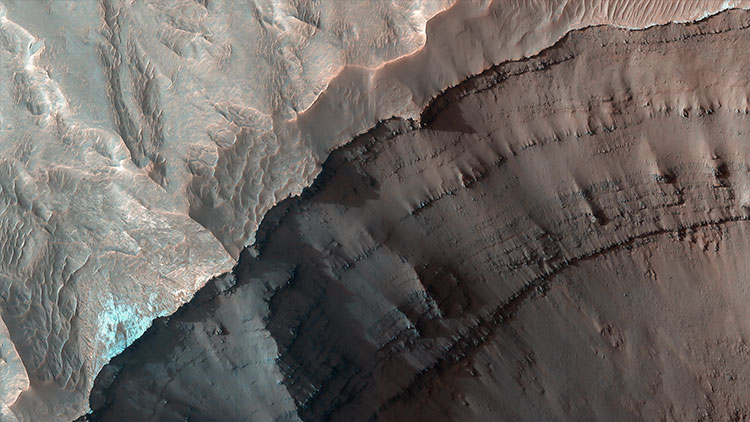#69 MARTIAN TERRAIN
Layering at Ganges Chasma.

This image shows the geologic contact between the walls of Ganges Chasma and the adjacent plains. Ganges Chasma is one of several deep troughs that make up the Valles Marineris system on Mars.
The upper slopes of the walls of Ganges have layering that appears dark, rough, and blocky, consistent with lava flows that are thought to make up the plains around Valles Marineris. Outside of Ganges on the plains is an unusual deposit that appears bright and is eroding back from the walls of Ganges, indicating the deposit isn't as resistant to erosion by the wind as the underlying lava flows.
The bright deposit is mantled by aeolian debris and dust, but along cliffs where erosion has exposed fresher surfaces, one can see meter-scale layering that appears smoother and brighter than the layering visible in the underlying lava flows. Some scientists interpret the layers in this deposit to be sediments laid down by water activity from a channel system located to the west, but explosive volcanism and aeolian airfall can also produce this fine-scale layering.
Written by: Cathy Weitz
The upper slopes of the walls of Ganges have layering that appears dark, rough, and blocky, consistent with lava flows that are thought to make up the plains around Valles Marineris. Outside of Ganges on the plains is an unusual deposit that appears bright and is eroding back from the walls of Ganges, indicating the deposit isn't as resistant to erosion by the wind as the underlying lava flows.
The bright deposit is mantled by aeolian debris and dust, but along cliffs where erosion has exposed fresher surfaces, one can see meter-scale layering that appears smoother and brighter than the layering visible in the underlying lava flows. Some scientists interpret the layers in this deposit to be sediments laid down by water activity from a channel system located to the west, but explosive volcanism and aeolian airfall can also produce this fine-scale layering.
Written by: Cathy Weitz





